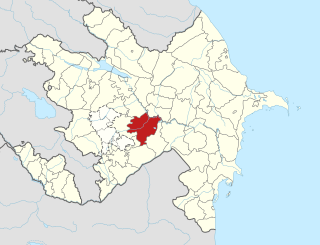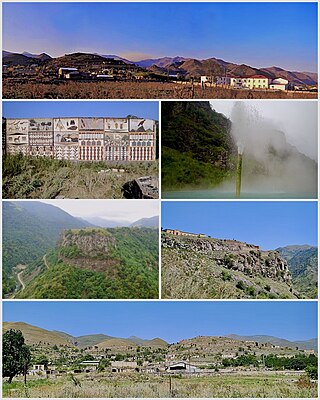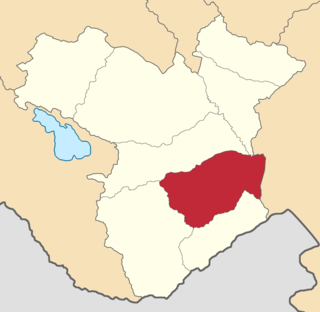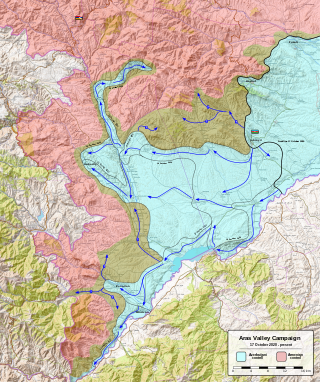
Nagorno-Karabakh is a region in Azerbaijan, covering the southeastern stretch of the Lesser Caucasus mountain range. Part of the greater region of Karabakh, it spans the area between Lower Karabakh and Syunik. Its terrain mostly consists of mountains and forestland.

Artsakh, officially the Republic of Artsakh or the Republic of Nagorno-Karabakh, was a breakaway state in the South Caucasus whose territory was internationally recognised as part of Azerbaijan. Between 1991 and 2023, Artsakh controlled parts of the former Nagorno-Karabakh Autonomous Oblast of the Azerbaijani Soviet Socialist Republic, including its capital Stepanakert. It had been an enclave within Azerbaijan from the 2020 Nagorno-Karabakh war until the 2023 Azerbaijani offensive, when the Azerbaijani military took control over the remaining territory controlled by Artsakh. Its only overland access route to Armenia after the 2020 war was via the 5 km (3.1 mi) wide Lachin corridor, which was placed under the supervision of Russian peacekeeping forces.

Aghjabadi District is one of the 66 districts of Azerbaijan. It is located in the centre of the country and belongs to the Karabakh Economic Region. The district borders the districts of Khojavend, Agdam, Barda, Zardab, Beylagan, and Fuzuli. Its capital and largest city is Aghjabadi. As of 2020, the district had a population of 136,800.

Barda District is one of the 66 districts of Azerbaijan. It is located in the center of the country in the Karabakh Economic Region. The district borders the districts of Tartar, Agdam, Aghjabadi, Zardab, Agdash, and Yevlakh. Its capital and largest city is Barda. As of 2020, the district had a population of 157,500.

Goranboy District is one of the 69 districts of Azerbaijan. It is located in the west of the country in the Ganja-Dashkasan Economic Region. The district borders the districts of Kalbajar, Tartar, Yevlakh, Samukh, and Goygol. Its capital and largest city is Goranboy. As of 2020, the district had a population of 105,000.

Zangilan District is one of the 66 districts of Azerbaijan. It is located in the south-west of the country and belongs to the East Zangezur Economic Region. The district borders the districts of Qubadli, Jabrayil, the Syunik Province of Armenia and the East Azerbaijan Province of Iran. Its capital and largest city is Zangilan. As of 2020, the district had a nominal population of 45,200.

The Nagorno-Karabakh conflict was an ethnic and territorial conflict between Armenia and Azerbaijan over the region of Nagorno-Karabakh, inhabited mostly by ethnic Armenians until 2023, and seven surrounding districts, inhabited mostly by Azerbaijanis until their expulsion during the 1990s. The Nagorno-Karabakh region was entirely claimed by and partially controlled by the breakaway Republic of Artsakh, but was recognized internationally as part of Azerbaijan. Azerbaijan gradually re-established control over Nagorno-Karabakh region and the seven surrounding districts.
Nagorno-Karabakh is located in the southern part of the Lesser Caucasus range, at the eastern edge of the Armenian Highlands, encompassing the highland part of the wider geographical region known as Karabakh. Under Russian and Soviet rule, the region came to be known as Nagorno-Karabakh, meaning "Mountainous Karabakh" in Russian. The name Karabakh itself was first encountered in Georgian and Persian sources from the 13th and 14th centuries to refer to lowlands between the Kura and Aras rivers and the adjacent mountainous territory.
The Battle of Kalbajar took place in March and April 1993, during the First Nagorno-Karabakh War. It resulted in the capture of the Kalbajar District of Azerbaijan by Armenian military forces.

Bako Sahaki Sahakyan is an Armenian politician who served as the third president of the de facto-independent Republic of Artsakh from 2007 to 2020. He is the longest-serving president of Artsakh.

Arayik Vladimiri Harutyunyan is an Armenian politician who served as the fourth president of the Republic of Artsakh from May 2020 to September 2023. Under his predecessor Bako Sahakyan, he served as the sixth and last Prime Minister from 2007 until the abolishment of that position in 2017 and as the first State Minister of the Republic of Artsakh from 2017 until his resignation in 2018. Harutyunyan led Artsakh through the 2020 Nagorno-Karabakh War with Azerbaijan, during which the republic lost most of the territory under its control. He resigned on 1 September 2023 in the midst of the Azerbaijani blockade of Nagorno-Karabakh.

Kalbajar is a city and the capital of the Kalbajar District of Azerbaijan. Located on the Tartar river valley, it is 458 kilometres (285 mi) away from the capital Baku.

Shahbulag Castle is an 18th-century fortress near Aghdam in Azerbaijan built by the Karabakh Khan Panah Ali.

The Shusha uezd was a county (uezd) of the Elizavetpol Governorate of the Russian Empire, and then of the Ganja Governorate of Azerbaijan Democratic Republic with its center in Shusha in 1840–1921.

The Leyla-Tepe culture of the South Caucasus belongs to the Chalcolithic era. It got its name from the site in the Agdam District of modern-day Azerbaijan. Its settlements were distributed on the southern slopes of Central Caucasus, from 4350 until 4000 B.C.

The political status of Nagorno-Karabakh remained unresolved from its declaration of independence from the Soviet Union on 10 December 1991, to its September 2023 collapse. During Soviet times, it had been an ethnic Armenian autonomous oblast of the Azerbaijan Soviet Socialist Republic. Following the dissolution of the Soviet Union, a conflict arose between local Armenians who sought to have Nagorno-Karabakh join Armenia and local Azerbaijanis who opposed this.

Relations between Azerbaijan and the Organization for Security and Cooperation in Europe (OSCE) began when Azerbaijan joined OSCE’s predecessor, the Conference on Security and Cooperation in Europe (CSCE), on January 30, 1992. This was the first European organization Azerbaijan joined. The CSCE transformed into the OSCE shortly afterwards in 1995.
Movsum Mammadov is the National Hero of Azerbaijan, and the warrior of the First Nagorno-Karabakh War.
The climate in most parts of Azerbaijan is semi-arid. In order to expand the areas of irrigation in a dry climate and to provide grape and orchards with water, many small and large reservoirs have been created. There are 140 reservoirs in the country. The total volume of reservoirs is 21.5 km3. Most reservoirs are regulated and used for irrigation. Reservoirs and hydroelectric stations created in the rivers Kura, Araz and Tartar are Shamkir, Mingachevir, Yenikend, Varvara, Araz and Sarsang. They are used to ensure the use of energy, irrigation and water supply.

Aras Valley campaign was a military operation launched by Azerbaijan against the breakaway Republic of Artsakh along the Aras River in the Azerbaijan–Iran border during the Second Nagorno-Karabakh War.
















